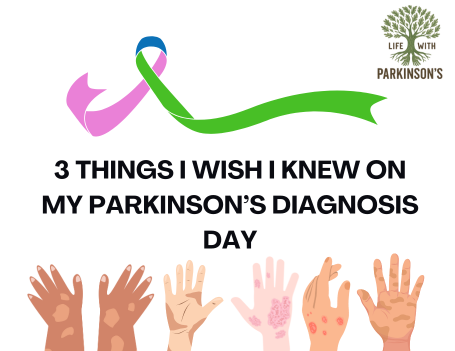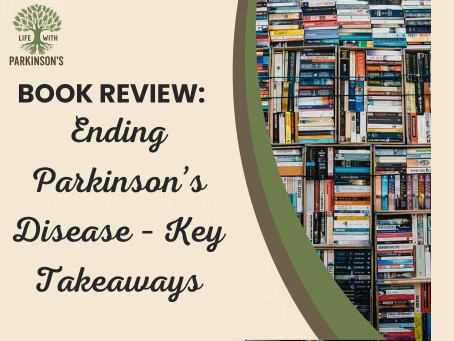Just when I thought I had my treatment plan under control, everything shifted. Living with Parkinson’s disease (PD) often feels like that — just when one issue is managed, another steps in.
Today, I want to share three vital things I’ve learned about dyskinesia — the kind of lessons I believe every person with Parkinson’s (PWP) and their caregivers should know.
Before I dive in, let me be clear: I am not a doctor. I’m simply someone living with Parkinson’s, sharing my journey and the insights I’ve gathered along the way. My experiences are my own, and while I hope they’re helpful, they’re not a substitute for professional medical advice. If you’re navigating Parkinson’s or dyskinesia yourself, please consult a healthcare professional for personalized guidance.
There’s a lot to cover, so let’s get started.
Being a Parkinson’s Warrior
The Warrior Mindset
“I fight for my health every day in ways that most people don’t understand. I’m not lazy. I’m a warrior!” – Unknown
This quote speaks to me deeply. It captures what so many of us living with chronic illnesses face daily. From the outside, the battle isn’t always visible — but those quiet, exhausting struggles are real.
Most people don’t see what it’s like to wake in the night to an hour and a half of intense dyskinesia. They don’t see the moments when I crawl to the bathroom, or call for help because I’m frozen in place. Yet we push through, because that’s what living with Parkinson’s demands of us.
If you consider yourself a PD warrior, I’d love to know: what would you want to say to others about your fight? Share it in the comments below.
Sponsor Spotlight: Rouge Care Canada

Before we continue, I want to thank today’s sponsor — Rouge Care Canada, providers of photobiomodulation (Red Light Therapy).
Red Light Therapy has been one of the very few devices that truly helps me manage dyskinesia. Of course, results vary from person to person, but if you’re looking for an option that may ease dyskinesia, it’s worth exploring. You can visit their website through the link below, which also supports Life With Parkinson’s.
We’ll dive into other possible solutions later in this post.
Understanding Dyskinesia
If you’re new to this, dyskinesia is essentially a side effect of levodopa (L-dopa) — the gold standard treatment for Parkinson’s. Experts don’t fully understand why it develops, but it’s a reality many of us face, especially after years of treatment or higher doses.
For me, dyskinesia had been under control for a while, but it’s returned, and now it’s something I have to manage daily.
And here’s the hard truth:If you’ve been on L-dopa for several years, dyskinesia may eventually become part of your journey too.
Why Nutrition Matters with Dyskinesia
Here’s something that isn’t talked about enough: dyskinesia burns a lot of calories.
During episodes, I sometimes feel like a fish out of water, flopping around in the bottom of a boat. It’s exhausting, it drains me, and it leaves me weak. And when your body burns through fat reserves, it starts breaking down muscle — increasing fall risk and overall weakness.
That’s why nutrition is critical. In my opinion, people with dyskinesia need to:
- Replace lost calories with quality protein and healthy fats.
- Consider easy-to-digest energy sources like organic coconut oil, which contains 50% MCT oil for an instant energy boost.
Strange as it sounds, sometimes the goal isn’t weight loss, but maintaining — or even gaining — enough weight to stay strong and resilient.
Keep Fighting
Dyskinesia may knock us down, but it doesn’t get to take our fight. Every day is a reminder that being a PD warrior means adapting, enduring, and pushing forward.
Let’s go warriors — it’s too late to give up now.
When Dyskinesia Gets Out of Control
Bravery in the Face of the Everyday Battle
“You wake up every morning to fight the same demons that left you so tired the night before, and that, my love, is bravery.” – Unknown
Parkinson’s — like many chronic diseases — can make even the start or end of a day feel unbearable. There are mornings I wake up wishing it were evening, and nights I go to bed wishing it were morning. Sometimes the fight is relentless.
I’m not immune to feeling like I’ve reached the end of my rope. There are days I want to wave the white flag. But if you open your eyes and choose to fight one more day — even when the odds haven’t changed — that is bravery.
Do you remember being told to “be brave” before something painful but necessary? Share your memory in the comments — I’d love to hear.
A Childhood Lesson in Bravery
For me, one memory stands out. As a kid, my sisters and I were shoveling snow off the back deck. I wasn’t paying enough attention, and when I walked behind one of them, I caught a shovel to the nose. Thankfully, not the eye — but it sent me to the hospital for stitches.
It took several people to hold me down for the procedure, and I’ve been afraid of needles ever since. That experience taught me: being brave isn’t always fun — but sometimes it’s necessary.
The Hard Truth About Dyskinesia
Here’s where bravery comes back into play: if you’re on L-dopa, dyskinesia may be waiting for you. And there are factors that can make it worse.
The reality is tough: There aren’t many ready-made solutions in the general medical community. Much of managing dyskinesia will be up to you and your caregiver.
That truth can feel heavy. But ignoring it won’t help — so let’s face it head-on.
What the Medical Community Offers
- Medication adjustments – Your doctor may tweak your L-dopa, but that can mean risking more “OFF” time.
- Deep Brain Stimulation (DBS) – A possible option, though not available to everyone.
- Other medications – Some may help, but results vary widely.
For more on this, you can check the APDA resource on dyskinesia: Dyskinesia: Understanding the Parkinson’s Med Side Effect | APDA
Triggers That Make Dyskinesia Worse
From personal research and lived experience, I’ve found several factors that aggravate dyskinesia:
- Lack of sleep – Probably the biggest trigger I’ve noticed.
- Stress and emotions – Both highs and lows can bring it on, but anger especially intensifies it.
- Diet – Processed sugar, processed foods, and caffeine all contribute.
- Screen time – Early morning computer use or late-night phone scrolling can spark dyskinesia.
- Overmedicating – Too much medication at the wrong times can create its own cycle of dyskinesia.
It’s a constant balancing act — one that requires daily attention.
Be Brave, Again
Managing dyskinesia isn’t simple, and much of it won’t come from a prescription. It may be trial and error, adjustment, and persistence — from both you and your caregiver.
It’s not easy. Some of it may hurt.But as I’ve learned: this is where bravery shows up.
Finding Hope When Dyskinesia Feels Overwhelming
The Weight of Loneliness
“Do not believe the things you tell yourself when you’re sad and alone.” – Unknown
Living with Parkinson’s can feel isolating. Dyskinesia, in particular, can drive you into anger, frustration, or depression. The spinning, the loss of control — it’s easy to slip into the thought: “It’s no use. I can’t fight anymore.”
If that sounds familiar, please hear this: you are not alone. Many of us face these same battles. And while that may not erase your pain, it’s important to remember that connection and shared experience exist — even when symptoms feel unbearable.
The Question Everyone Asks
At this point, you may be wondering:“Dave, have you found anything that actually helps with dyskinesia?”
The answer is yes — though the list isn’t long.
Red Light Therapy (Photobiomodulation)
One of the most effective tools I’ve used is Red Light Therapy (RLT), also known as photobiomodulation. Thanks to our sponsor Rouge Care Canada, I’ve had access to this technology.
For me, it has:
- Reduced dyskinesia
- Helped with other Parkinson’s symptoms
- Given me a sense of relief when little else worked
I honestly would be lost without my panel.
Medications — Limited but Available
There are medications out there that may help with dyskinesia. Unfortunately, results are mixed. I personally don’t know anyone who’s had outstanding success with them, but your experience may differ.
If you have found something that works, please share it in the comments — we learn best from each other.
Exercise: The #1 Natural Treatment
Here’s the good news: exercise is one of the most effective tools we have against dyskinesia.
For me, fast walking has been a game-changer. It has:
- Reduced the intensity of my symptoms
- Helped me cut back on meds (at certain times of day)
- Kept my mental health in check when dyskinesia threatened to overwhelm me
Exercise may not be possible for everyone at the same level — but for those who can, it can make a profound difference.
Other Promising Treatments
- Deep Brain Stimulation (DBS): My YouTube friend GoPro Goalie underwent DBS, and it has dramatically improved his quality of life. His channel is worth checking out if you want to see a real-life transformation.
- The Beech Band: Still in early stages, but showing good results with dyskinesia. It’s not widely available yet, but worth keeping an eye on.
Endurance and Carrying On
At the end of the day, when dyskinesia is raging, sometimes all I can do is wait for it to pass.
That’s the hardest truth: sometimes endurance is the only option.But we endure. We carry on. Because — really — what else is there to do?
Living with Dyskinesia, Fighting with Courage
Living with Parkinson’s means living with constant change. Just when you think you have things figured out, another challenge shows up — like dyskinesia. But here’s what I want you to take away:
- You are not weak — you are a warrior.
- Bravery isn’t about not feeling fear, but facing each day despite it.
- There may not be a single perfect solution, but there are tools, strategies, and a community of people walking this path with you.
Some days, the best we can do is endure and carry on. And that is enough.
Sponsor Spotlight: Rouge Care Canada

A special thank you to Rouge Care Canada, today’s sponsor. Their Red Light Therapy panels have been one of the very few things that actually help me manage my dyskinesia symptoms.
While results will vary for everyone, Red Light Therapy (photobiomodulation) has personally:
- Reduced my dyskinesia episodes
- Supported other aspects of my Parkinson’s management
- Given me a sense of control on difficult days
If you’d like to explore their products, you can visit their website using the link below. Doing so also supports Life With Parkinson’s, which I deeply appreciate.
A Note for Caregivers
If you are a caregiver, know this: your role is irreplaceable. Dyskinesia is exhausting not just for the person experiencing it, but also for those who support them. Patience, compassion, and understanding are as vital as any medication. Please take care of yourself, too — your health and well-being matter.
Important Medical Note
I am not a doctor. Everything I share here comes from my own lived experience with Parkinson’s. Dyskinesia affects everyone differently, and what works for me may not work for you. Please, before making changes to your medication, exercise, or treatment plan, consult your neurologist or movement disorder specialist.
Sources & Further Reading
Here are some resources you may find helpful:
- American Parkinson Disease Association (APDA) – Dyskinesia: Understanding the Parkinson’s Med Side Effect
- Michael J. Fox Foundation – Dyskinesia and Parkinson’s Disease
- Parkinson’s Foundation – Treatment Options for Dyskinesia



